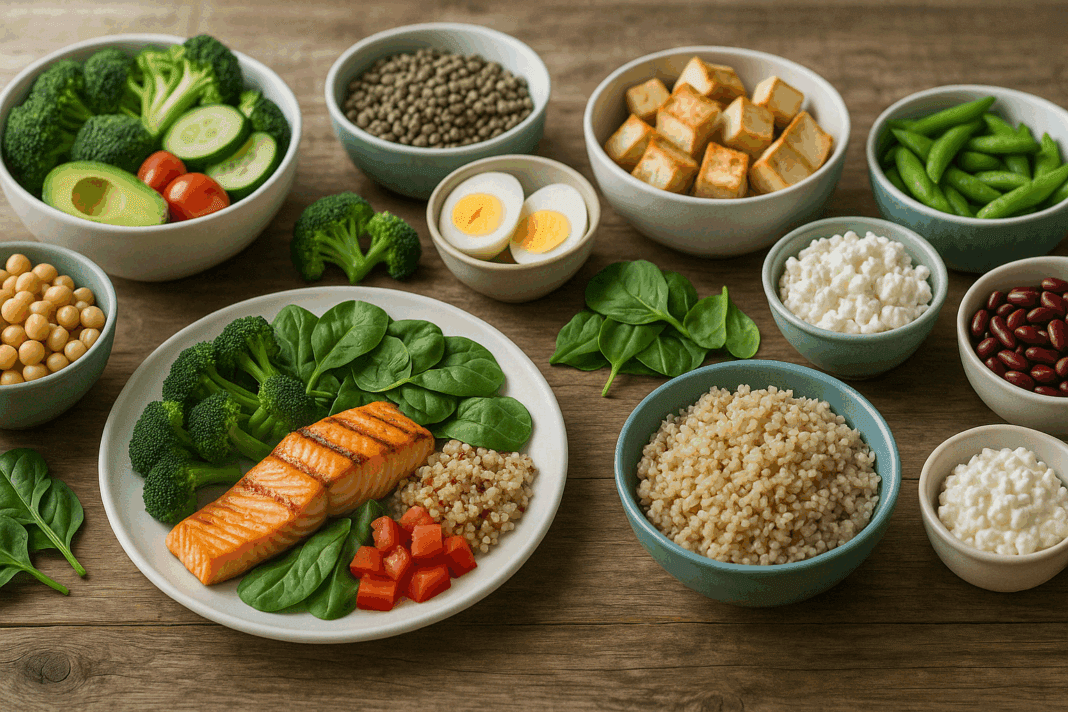In the pursuit of effective and lasting weight loss, high-protein eating has emerged as a powerful nutritional strategy. Research-backed, metabolism-boosting, and satiety-promoting, a high protein diet meal plan offers more than just a temporary fix—it lays the groundwork for a sustainable shift in how we nourish our bodies. With careful planning and a thoughtful approach, it’s possible to create a high protein nutrition plan that supports weight loss while aligning with long-term health goals. This guide unpacks the science, structure, and practical implementation of a protein-rich approach to healthy eating.
You may also like: Smart Meal Prep for Weight Loss: Expert-Approved Lunch Ideas and Recipes to Stay on Track
Understanding the Power of Protein for Weight Loss
Protein serves as one of the body’s most essential macronutrients, supporting everything from muscle repair to immune function. But beyond its basic biological functions, protein also plays a unique role in weight regulation. A high protein diet plan for weight loss helps curb hunger hormones such as ghrelin while boosting satiety-inducing hormones like peptide YY and GLP-1. This hormone-balancing effect can reduce overall caloric intake without the psychological toll of deprivation.
Metabolically, protein requires more energy for digestion compared to carbohydrates or fats, a phenomenon known as the thermic effect of food (TEF). Studies show that diets higher in protein can increase daily energy expenditure by as much as 100 calories, creating a modest but meaningful metabolic advantage. In addition, protein helps preserve lean muscle mass during caloric restriction, which is essential for maintaining metabolic health.
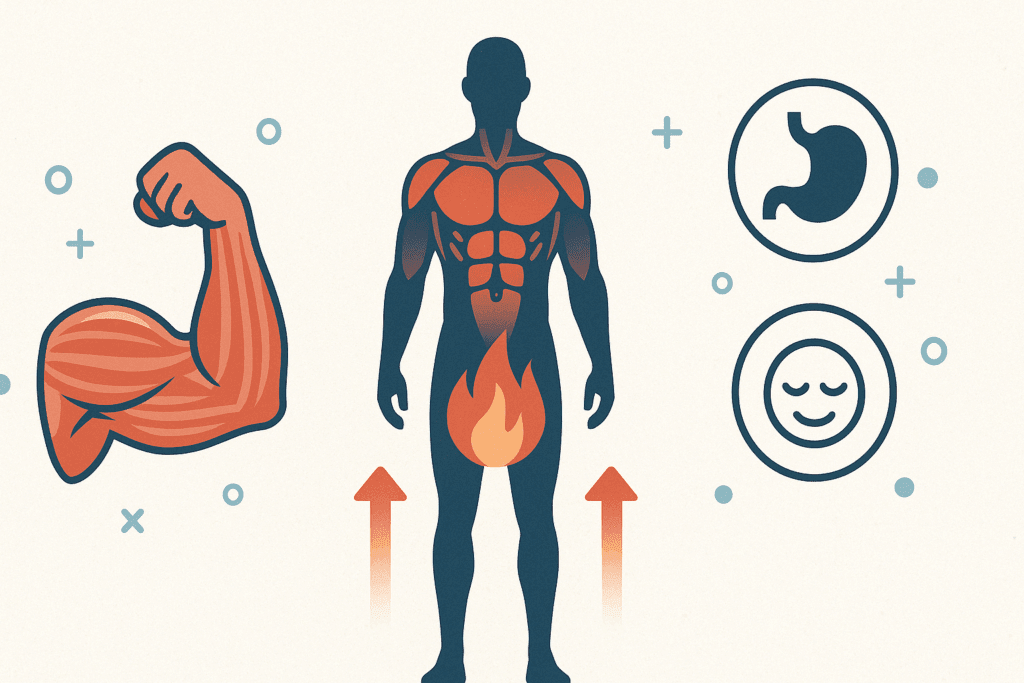
Designing a High Protein Meal Plan That Works
Creating a high protein eating plan requires more than just piling on chicken breasts and protein shakes. A truly effective high protein meal plan considers macronutrient balance, fiber content, and variety. To maximize the benefits, each meal should ideally include a source of lean protein, complex carbohydrates, healthy fats, and fiber-rich vegetables or legumes.
For example, a protein diet plan might include meals like lentil and quinoa bowls, tofu stir-fries with broccoli and brown rice, or salmon with roasted vegetables and farro. High protein high fiber meals are particularly effective for weight management, as the fiber slows digestion and extends satiety. Incorporating both animal and plant-based proteins ensures nutritional diversity, and rotating protein sources can help prevent dietary fatigue.
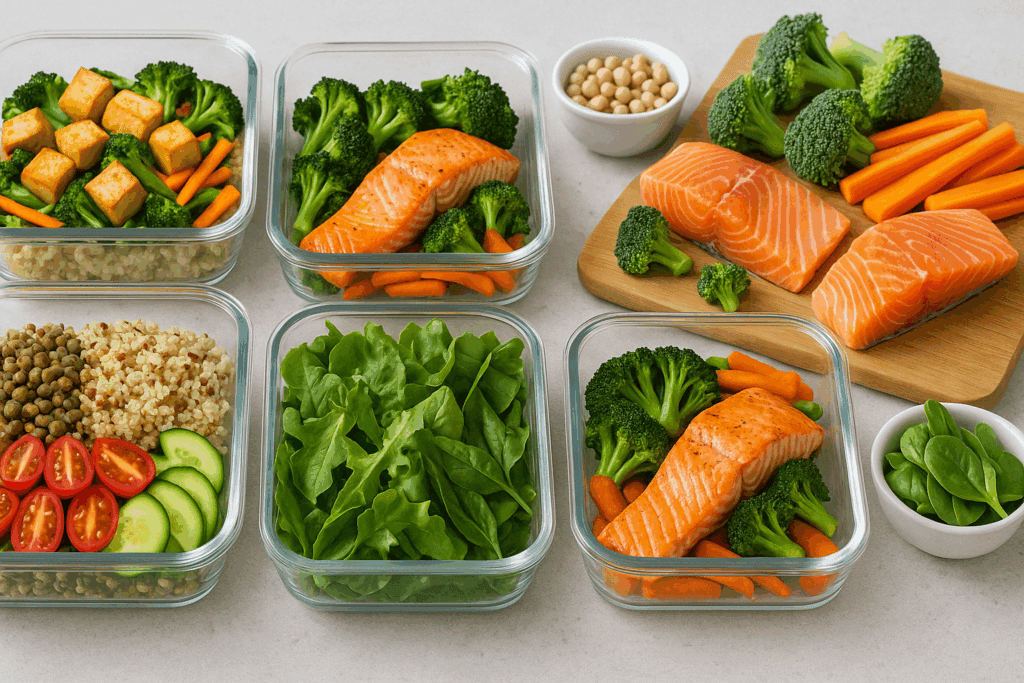
How Much Protein Do You Really Need?
For individuals aiming for weight loss, research suggests consuming between 1.2 to 2.0 grams of protein per kilogram of body weight per day. For a 150-pound person (approximately 68 kilograms), that translates to 82 to 136 grams of protein daily. This target should be distributed evenly across meals and snacks for optimal absorption and effectiveness.
However, needs vary depending on factors like age, activity level, and body composition goals. Resistance training increases protein requirements, as does older age due to the body’s declining efficiency in muscle protein synthesis. A well-planned high protein food plan can accommodate these variables with a thoughtful combination of whole foods and, if necessary, supplementation.
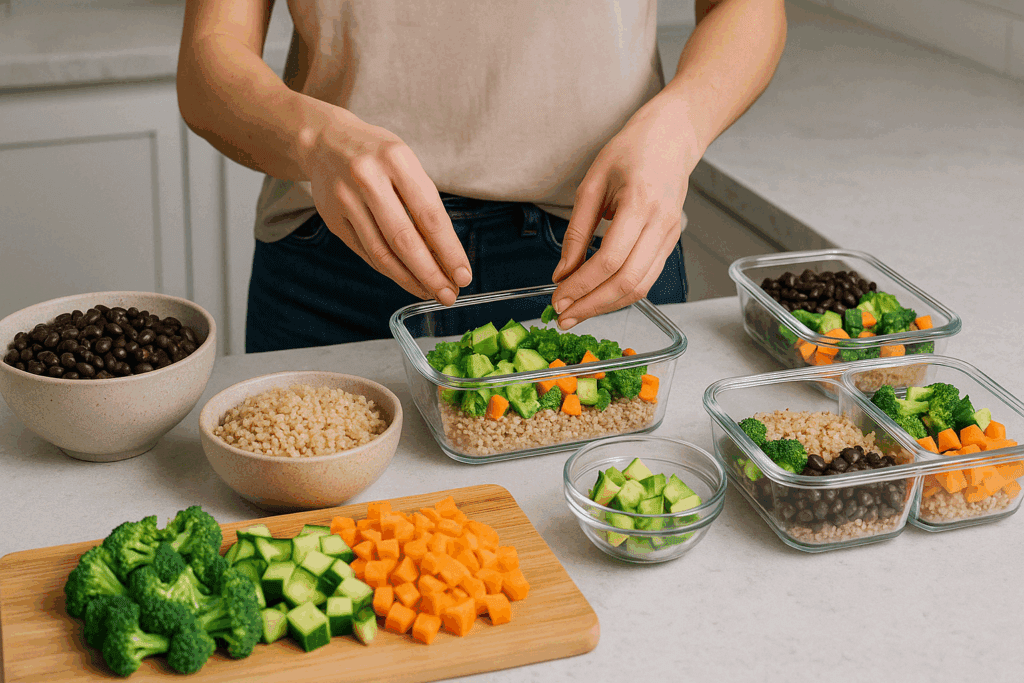
Incorporating High Protein High Fiber Recipes Into Everyday Life
One of the most effective ways to maintain a high protein diet menu is by integrating easy high protein high fiber meals into daily routines. Fiber-rich ingredients like legumes, whole grains, vegetables, and seeds pair well with protein sources such as eggs, tempeh, or grilled poultry. Dishes like black bean and quinoa bowls, chia pudding with protein powder, or lentil soups with tofu offer excellent examples of balanced protein and fiber meals.
High protein high fiber meal prep is another essential component of success. Planning and preparing meals in advance not only saves time but also prevents last-minute food choices that may not align with weight loss goals. Preparing a batch of high protein high fiber dinners on Sunday—such as stuffed bell peppers with lentils and brown rice or stir-fried edamame with soba noodles and mixed greens—can provide a week’s worth of nutritious, satisfying meals.
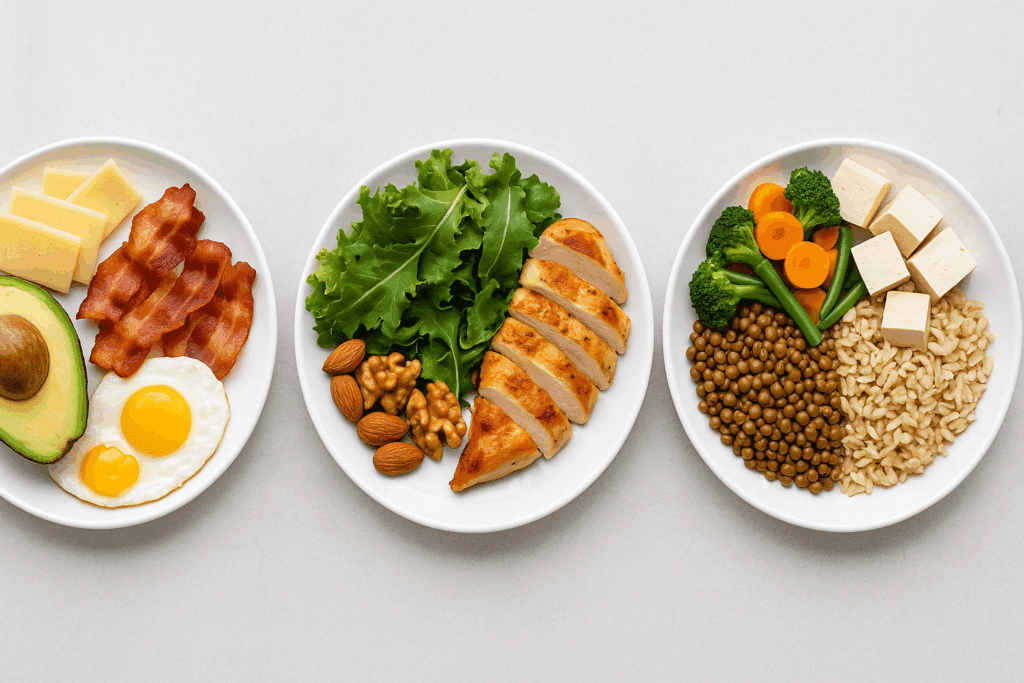
Protein Quality Matters: Whole Foods Over Processed Powders
While protein powders and supplements have their place, especially for athletes or those with increased needs, the foundation of any high protein meal planner should be whole, minimally processed foods. Whole protein sources such as beans, fish, lentils, nuts, seeds, tofu, eggs, and lean meats provide not only amino acids but also important micronutrients and phytochemicals.
Overreliance on processed protein bars or shakes can lead to dietary imbalances and reduced intake of fiber, vitamins, and antioxidants. A balanced high protein menu plan should prioritize real foods and reserve supplements for specific needs or logistical convenience. This approach supports the body’s long-term health while still providing adequate protein intake.
Comparing Keto, Low Carb, and High Protein Diets
Many people confuse a high protein diet with a low carbohydrate or ketogenic diet. While all three can overlap, they differ in key ways. A ketogenic diet, for example, drastically reduces carbohydrate intake to force the body into ketosis, using fat as its primary energy source. But is keto a low carb diet? Yes, though not all low carb diets are ketogenic. The distinction lies in the degree of carbohydrate restriction.
Comparing a ketogenic diet vs low carb approach reveals that the keto diet is stricter and harder to sustain long-term. Meanwhile, high protein plans offer more flexibility and are often easier to incorporate into everyday life. When assessing a low carb diet keto diet comparison, it becomes clear that the ketogenic diet limits protein to prevent gluconeogenesis (the conversion of protein to glucose), while a high protein diet emphasizes ample protein intake to support muscle retention and satiety.
So, is keto a good diet? For certain individuals, especially those with epilepsy or insulin resistance, a medically supervised keto plan may offer benefits. But is a keto diet sustainable for most people? Research suggests many struggle to adhere long-term, particularly due to social constraints, limited food choices, and potential nutrient deficiencies. In contrast, a high protein eating plan or high protein diet menu tends to be more practical and inclusive, making it a more realistic long-term solution for many.
Structuring a Protein Diet Meal Plan for Real Life
A successful high protein diet plan integrates seamlessly into a person’s lifestyle rather than requiring a complete overhaul. For breakfast, options like Greek yogurt with berries and chia seeds, a tofu scramble with vegetables, or a protein smoothie with nut butter and flaxseeds provide satisfying, fiber-rich starts to the day. Lunch might include lentil salad wraps, grilled tempeh with quinoa and spinach, or chickpea pasta with edamame and arugula.
Dinner choices should be both nutrient-dense and flavorful. High protein high fiber dinner recipes such as seared salmon with sweet potatoes and kale, black bean enchiladas with avocado, or baked tofu over farro with roasted vegetables offer nourishment and satiety. Snacks can include hard-boiled eggs, roasted chickpeas, or almond butter on whole grain crackers—simple options that align with a high protein high fiber meal plan.
The Role of Meal Planning and Preparation
Meal planning is one of the most effective tools for weight loss success. A high protein meal planner helps streamline decision-making, reduce food waste, and ensure consistent nutrient intake. Tools like weekly meal calendars, grocery lists, and batch cooking strategies can turn good intentions into practical habits. Those following a protein diet for weight loss meal plan benefit most from planning meals that can be prepared quickly, stored easily, and enjoyed repeatedly.
High protein high fiber meal prep techniques include roasting trays of vegetables, pre-cooking grains like quinoa or brown rice, marinating proteins in advance, and portioning out snacks for the week. This level of organization makes it easier to stick with a protein and fiber meals strategy even when life gets busy or stressful.
Addressing Common Challenges and Misconceptions
One misconception is that a high protein plan must be meat-centric. In truth, plant-based protein sources such as beans, lentils, tofu, tempeh, nuts, and seeds can form the foundation of an effective high protein food plan. For vegetarians and vegans, combining complementary proteins across meals (such as rice and beans or hummus and whole wheat pita) ensures all essential amino acids are consumed.
Another challenge is navigating the perceived high cost of protein-rich foods. While some animal proteins can be expensive, many plant-based options are among the most affordable items in the grocery store. Lentils, canned beans, oats, and frozen edamame provide excellent value, making high protein high fiber recipes accessible to a wide range of budgets.
Finally, there’s concern about protein overconsumption and kidney health. While individuals with pre-existing kidney disease should moderate protein intake, healthy individuals can safely consume higher protein diets without harm. Clinical trials continue to affirm that a high protein diet for weight loss meal plan does not negatively impact kidney function in otherwise healthy adults.
Why High Protein Diets Align With Mindful Eating and Healthier Lifestyles
A high protein nutrition plan supports mindful eating by promoting satiety, reducing cravings, and encouraging intentional food choices. Rather than grazing mindlessly or succumbing to blood sugar crashes, individuals following a high protein diet plan tend to feel more in control of their eating patterns. Meals take on a purpose: to nourish, to sustain, and to empower.
Mindful eating also involves slowing down, appreciating flavors and textures, and recognizing true hunger and fullness cues. Protein and fiber work synergistically to support these cues, creating meals that are not only filling but also emotionally satisfying. In this way, a high protein and fiber meals approach supports emotional and physical well-being, integrating seamlessly into a healthier lifestyle.

Frequently Asked Questions: High Protein Diet Meal Plan for Weight Loss
1. How can I personalize a high protein diet meal plan if I follow a plant-based lifestyle?
A high protein diet meal plan can be successfully adapted for those following a plant-based lifestyle by focusing on diverse, complementary protein sources. Pairing foods like brown rice with lentils, or hummus with whole grain pita, ensures you’re getting all essential amino acids. A high protein high fiber meal plan can include tofu stir-fries, tempeh salads, or chickpea curries with quinoa. Incorporating high fiber protein recipes like black bean and edamame bowls provides both muscle-supporting protein and gut-friendly fiber. Utilizing a high protein meal planner tailored to plant-based foods helps balance intake and supports consistent weight loss outcomes.
2. What are some science-based strategies for overcoming hunger on a high protein meal plan?
Beyond increasing protein intake, strategic meal timing and food pairing can enhance satiety. Including healthy fats such as avocado or nuts with protein sources slows digestion, prolonging fullness. High protein and fiber meals are particularly effective because fiber delays gastric emptying. A high protein food plan that includes snacks like Greek yogurt with chia seeds or roasted chickpeas with olive oil provides sustained energy between meals. Finally, hydration plays a critical role; sometimes thirst is mistaken for hunger, so integrating water-rich foods into a high protein diet menu can help regulate appetite naturally.
3. How can I follow a high protein diet plan for weight loss without relying heavily on supplements?
While protein powders and shakes can be convenient, a whole-food-based high protein nutrition plan offers more nutritional benefits. Using ingredients like legumes, seeds, nuts, tempeh, and whole grains allows you to meet protein goals without overreliance on processed items. High protein high fiber recipes like lentil soup with farro or stuffed bell peppers with black beans and quinoa are nutrient-dense and satisfying. Planning ahead with high protein high fiber meal prep ensures that real food remains the foundation of your protein eating plan. Supplements should only fill gaps when necessary—not serve as dietary mainstays.
4. What is the most effective way to track progress on a protein diet meal plan for weight loss?
Tracking more than just the scale is essential. A high protein diet for weight loss meal plan should be evaluated based on body composition, energy levels, and appetite control. Using apps that log macronutrients and fiber intake helps ensure your high protein and fiber meals are balanced. Consider journaling physical performance, such as improvements in strength or endurance, which reflect muscle retention. Regularly reviewing your high protein meal plan for weight loss can help identify which meals optimize your energy and which might need adjustments for variety or nutrient density.
5. Can a high protein high fiber meal plan help support hormonal balance in women?
Yes, a well-structured high protein eating plan can support hormonal health, particularly for women in midlife or those managing conditions like PCOS. Protein and fiber meals help stabilize blood sugar and insulin response, which are crucial for hormonal regulation. A high protein high fiber dinner with foods like lentils, spinach, and flaxseed can support estrogen metabolism and reduce inflammation. Unlike restrictive low-calorie diets, a high protein diet meal plan supports consistent energy and reduces stress hormone spikes. Including omega-3-rich proteins like chia seeds or walnuts in your high protein food plan adds anti-inflammatory benefits.
6. What are the psychological benefits of following a high protein and fiber meals approach?
A high protein meal plan can foster a greater sense of control around eating by reducing emotional eating triggers. Balanced protein diet meal plans support mood by stabilizing blood glucose, helping prevent the emotional highs and lows that lead to overeating. The structure of a high protein menu plan often reduces decision fatigue and promotes mindful eating practices. As individuals experience physical benefits, they may also gain a sense of empowerment, which reinforces healthy behaviors. Moreover, the nutrient density in protein and fiber meals supports neurotransmitter health, including serotonin and dopamine pathways.
7. How does a high protein meal planner support long-term adherence and success?
Consistency is key in weight loss, and a high protein meal planner helps eliminate guesswork while supporting nutrient variety. Planning meals in advance encourages balance across protein sources, fiber types, and micronutrients, preventing boredom. A protein diet for weight loss meal plan that includes rotating meals like tempeh bowls, lentil tacos, and quinoa salads ensures you’re meeting nutritional goals without repetition. High protein high fiber meal prep also reinforces time efficiency, making it easier to maintain healthy habits during busy weeks. Tracking results using a structured meal planner can also improve accountability and foster motivation.
8. Are there specific high protein high fiber recipes that support gut health?
Yes, many high fiber protein recipes benefit the microbiome while supporting satiety. Fermented proteins like tempeh and miso, combined with prebiotic-rich vegetables such as onions, garlic, and asparagus, enhance digestive health. A high protein plan that includes meals like miso tempeh noodle bowls or lentil and leek soup promotes both protein synthesis and gut diversity. High protein high fiber dinners that include cooked cruciferous vegetables and legumes further support the production of short-chain fatty acids, which protect gut lining integrity. These meals, when regularly featured in a high protein nutrition plan, reduce bloating and improve regularity.
9. How can I transition from a standard diet to a protein-focused eating plan without feeling deprived?
Gradual changes make for smoother transitions. Begin by increasing the protein content of existing meals, such as adding tofu or chickpeas to salads, or swapping out white rice for lentil pilaf. A high protein diet menu that mirrors familiar dishes—like chili, pasta, or wraps—but uses higher-protein ingredients makes the shift less disruptive. Introducing easy high protein high fiber meals such as chickpea pasta with spinach pesto or lentil bolognese helps satisfy cravings while promoting weight loss. Focusing on the abundance of nourishing options in a high protein menu plan shifts mindset from restriction to empowerment.
10. What role do cultural and social preferences play in shaping a successful protein diet plan?
Cultural foods and preferences must be respected and integrated for a high protein diet plan to be sustainable. Including traditional legumes, spices, and preparation methods can turn a high protein meal plan into a culturally aligned lifestyle. For example, Indian dals, Ethiopian lentil stews, or Latin American black bean dishes offer nutrient-rich options within a high protein high fiber meal plan. Respecting food heritage enhances emotional satisfaction and makes the protein diet plan for weight loss feel like a personal journey rather than a generic prescription. Encouraging family-style protein and fiber meals can also foster shared health goals within households.

Conclusion: Building a Sustainable, Science-Backed High Protein Eating Strategy
Developing a high protein diet meal plan for weight loss doesn’t mean sacrificing taste, variety, or sustainability. When grounded in whole foods, mindful planning, and evidence-based principles, it becomes a realistic path toward long-term health. A high protein high fiber meal plan promotes satiety, stabilizes blood sugar, and preserves lean mass—key pillars of any effective weight management strategy.
By incorporating easy high protein high fiber meals into daily routines, leveraging a reliable high protein meal planner, and maintaining nutritional balance, individuals can build a lifestyle that not only supports weight loss but also fosters overall vitality. Compared to restrictive alternatives, such as low carb diet keto diet plans, a high protein diet menu offers flexibility, enjoyment, and greater long-term adherence. The question isn’t whether a high protein plan works, but how thoughtfully and consistently it’s implemented. With the right mindset and tools, it can become the cornerstone of a healthier, more empowered way of eating.
Was this article helpful? Don’t let it stop with you. Share it right now with someone who needs to see it—whether it’s a friend, a colleague, or your whole network. And if staying ahead on this topic matters to you, subscribe to this publication for the most up-to-date information. You’ll get the latest insights delivered straight to you—no searching, no missing out.
Further Reading:
High-Protein Meal Plan to Help Lose Weight, Created by a Dietitian

